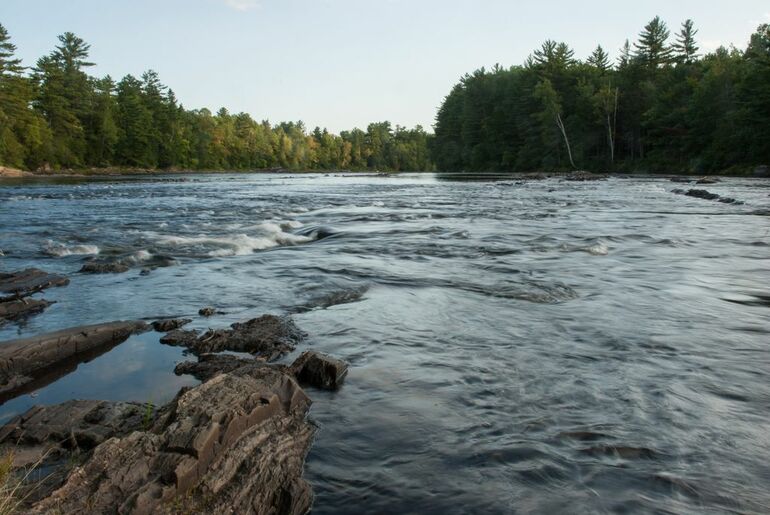Two visions for Katahdin region: Gov. LePage vs. Lucas St. Clair
 Photo / James McCarthy
A view of the East Branch of the Penobscot River near the Katahdin Woods and Waters National Monument.
Photo / James McCarthy
A view of the East Branch of the Penobscot River near the Katahdin Woods and Waters National Monument.
Two sharply different visions for the future of the Katahdin region were presented during Tuesday’s Republican-led hearing in Washington, D.C., looking at presidentially declared national monuments, including Maine’s Katahdin Woods and Waters National Monument.
Only four witnesses were invited to speak before the Federal Lands Subcommittee of the House Natural Resources Committee.
Two were from Maine: Gov. Paul LePage, who characterized former President Barack Obama’s creation of the 87,500-acre national monument last August as an abuse of power that ignores the historic economic uses of the forest, and Lucas St. Clair, son of Roxanne Quimby, whose nonprofit Elliotsville Plantation donated the land and pledged a $40 million endowment for the project. St. Clair described Maine’s national monument as a “beautiful and amazing place” that is culturally and historically significant and a “model of how the Antiquities Act should work.”
Here are some excerpts from their testimony, gleaned from a live video recording of the hearing.
Gov. Paul LePage: “Maine has a long history of prudent stewardship of its forest resources with minimal federal assistance. This is because Maine citizens and landowners show great respect for our natural resources and they understand the importance of conserving them for future generations. Our state is committed to supporting the forest products industry while at the same time strategically conserving valuable tracts of land.
“Mainers understand the benefits of our 17 million acres of forest to our economy and we have historically supported the industries that rely on this land without interference of the federal government. That is why it should be no surprise that the designation of this monument on a former working forest by former President Obama is very concerning to Maine residents living in that area and around the state. The National Park Service seems to have blatantly disregarded key indicators of this opposition.
“The area [Lucas St. Clair] is speaking about is one of the highest unemployment areas in the state of Maine. And I will say this, the state of Maine has an unemployment rate of 3%, which is very very pleasant. .. I will say this to Mr. St. Clair, the growth of the state of Maine is on the coast and between May 31 and Labor Day we will have 40 million visitors but they will be to the coast. Very few are going to be in the mosquito area.
“What’s going to happen to this monument, which abuts one of the jewels in the state of Maine, Baxter State Park, is that it’s going to make it vulnerable to catastrophic fires”. … At this point, LePage was interrupted by his questioner, who pointedly asked him to answer the question of whether he sees any potential economic benefit from the national monument designation. LePage replied, “Not in this area. Not in my lifetime. Not until this forest grows up again.”
Lucas St. Clair: “In my lifetime, I didn’t witness the aforementioned heyday. Instead, I grew up in a small town called Dover-Foxcroft with a population of 4500 people and witnessed a different economic situation. I watched Millinocket, a nearby town where most working-aged men worked in either the paper mill or in the woods supplying the mill, start a slow decline. By 2008, the paper mill in Millinocket closed, followed by more mill closures in the region. Many of my friends moved out of northern Maine seeking jobs further south or elsewhere. Northern Maine is not thriving and the population continues to shrink. This incredible region that so many of us care about is struggling.
“This is northern Maine’s reality. Mills are closed and sold for scrap metal. Houses and commercial real estate sit on the market indefinitely. You don’t need a degree in business or a certificate of election to know what has been happening to the economy in northern Maine. It’s obvious.
“Whether it’s the wild rivers, critical wildlife habitat, historical significance, awe-inspiring scenery, or night skies and northern lights — the area is a natural and cultural wonder that Americans should visit and embrace much like Acadia National Park on Maine’s coast.
“So was there urgency to protect Katahdin Woods and Waters National Monument? Yes, there were lands that were up for sale, and there is economic urgency. Our community needs investment and quickly. My family chose to focus on a national monument as a way to diversify the economy while saving some of the region’s defining characteristics. We hope other philanthropists, business owners and real estate investors follow our lead in promoting the regional economy. We have reason to hope this could happen.
“Since the designation of the Katahdin Woods and Waters National Monument, the towns around Katahdin Woods and Waters National Monument are witnessing economic improvement. Real estate sales have picked up, multi-season visitation is increasing and business investments are happening. A foundation is making a $5 million investment to build an outdoor education facility just south of the national monument. Elliotsville Plantation continues to work with the National Park Service to make infrastructure improvements to the monument as well as raise money toward our commitment of a $40 million endowment for the monument.
“National monuments are one component of the communities which they are a part. Some provide recreation opportunities, some protect sacred sites, some preserve the stories of our past, and some protect our natural resources for the future. They can support tourism or new residents to an area. In our case, I hope the monument attracts a variety of industries so some of my old friends are able to find jobs and move back to the region to raise their families. These communities need diversified economies. The days of one industry dominating an area are long gone.”
Residents travel to D.C. to support national monument
The Natural Resources Council of Maine, a strong advocate of the Katahdin Woods and Waters National Monument, issued a news release Tuesday identifying Katahdin region residents who weren’t invited to address the committee, but who also travelled to Washington to make their case. For the full release go here.
Among the local businesspeople quoted is Matt Polstein, founder and owner of the New England Outdoor Center on Millinocket Lake, who said: “The national monument has created a magnet to draw the type of high-wage, non-exportable jobs that are desperately needed in the Katahdin region, while also conserving this place of exceptional natural beauty and historic value for the benefit of future generations. Visits to my business have increased significantly since the designation of the monument.”














Comments